Table of Contents
- I. Why Your Business Consultant Website is Your Most Valuable Asset
- A. Establishing Authority and Trust: The Foundation of Consulting
- B. Generating Leads and Converting Prospects: Turning Clicks into Clients
- C. Showcasing Your Expertise and Services: Letting Your Work Speak for Itself
- D. Expanding Your Reach and Visibility: Reaching Clients You Never Knew Existed
- E. Streamlining Communication and Building Relationships: Fostering Long-Term Partnerships
- II. Planning Your Business Consultant Website: Laying the Groundwork for Success
- A. Defining Your Target Audience: Who Are You Trying to Reach?
- B. Defining Your Brand Identity: Creating a Unique and Memorable Image
- C. Choosing a Domain Name and Hosting Provider: Establishing Your Online Presence
- D. Mapping Out Your Website Structure: Creating a User-Friendly Experience
- E. Keyword Research: Identifying the Terms Your Clients Are Searching For (Consulting Design)
- III. Choosing the Right Platform: Building Your Website on a Solid Foundation
- A. WordPress: The Power and Flexibility of Open Source
- B. Squarespace: The All-in-One Simplicity
- C. Wix: The Drag-and-Drop Ease
- D. Considerations for Choosing the Right Platform: Balancing Simplicity and Control
- IV. Designing Your Website: Creating a Visually Appealing and Engaging Experience
- A. Choosing a Theme or Template: Starting with a Solid Foundation
- B. Optimizing for Mobile: Catering to On-the-Go Users
- C. Using High-Quality Images and Videos: Enhancing Visual Appeal
- D. Implementing a Clear and Intuitive Navigation: Guiding Users Through Your Website
- E. Color Palette and Typography: Creating a Consistent Brand Experience
- V. Creating Compelling Content: Showcasing Your Expertise and Value
- A. Writing Engaging Homepage Copy: Capturing Attention Immediately
- B. Crafting Informative Service Pages: Detailing Your Offerings
- C. Developing Compelling Case Studies: Showcasing Your Successes
- D. Gathering and Displaying Testimonials: Building Trust and Credibility
- E. Creating a Blog: Sharing Your Expertise and Providing Value
- F. Optimizing Content for SEO: Attracting Organic Traffic
- VI. Implementing Essential Features: Enhancing Functionality and User Experience
- A. Contact Forms: Making it Easy to Connect
- B. Appointment Scheduling Tools: Streamlining the Booking Process
- C. Live Chat: Providing Real-Time Support
- D. Email Marketing Integration: Building Your Mailing List
- E. Social Media Integration: Expanding Your Reach and Engagement
- VII. Testing and Launching Your Website: Ensuring a Smooth and Successful Debut
- A. Cross-Browser Compatibility Testing: Ensuring Consistent Performance
- B. Mobile Responsiveness Testing: Verifying Mobile-Friendliness
- C. Functionality Testing: Ensuring All Features Work as Expected
- D. Content Review: Proofreading and Accuracy
- E. Speed Optimization: Ensuring Fast Loading Times
- F. Security Audit: Protecting Your Website and Data
- G. Launching Your Website: Making it Live to the World
- VIII. Promoting Your Website: Driving Traffic and Generating Leads
- A. Search Engine Optimization (SEO): Attracting Organic Traffic
- B. Social Media Marketing: Engaging Your Audience and Driving Traffic
- C. Email Marketing: Nurturing Leads and Driving Conversions
- D. Paid Advertising: Reaching a Targeted Audience
- E. Content Marketing: Providing Value and Attracting Leads
- IX. Qrolic Technologies: Your Partner in Building a Powerful Online Presence
- A. Custom Website Design and Development: Tailored to Your Specific Needs
- B. SEO Optimization: Ranking Higher in Search Results
- C. Content Creation: Engaging Your Audience and Showcasing Your Expertise
- D. Digital Marketing: Driving Traffic and Generating Leads
- E. Website Maintenance and Support: Ensuring Your Website Stays Up-to-Date and Secure
- X. Maintaining and Updating Your Website: Ensuring Long-Term Success
- A. Regularly Updating Content: Keeping Your Website Fresh and Relevant
- B. Monitoring Website Performance: Tracking Key Metrics
- C. Security Updates: Protecting Your Website from Threats
- D. Plugin Updates: Ensuring Compatibility and Functionality
- E. Theme Updates: Maintaining a Modern and Functional Design
I. Why Your Business Consultant Website is Your Most Valuable Asset
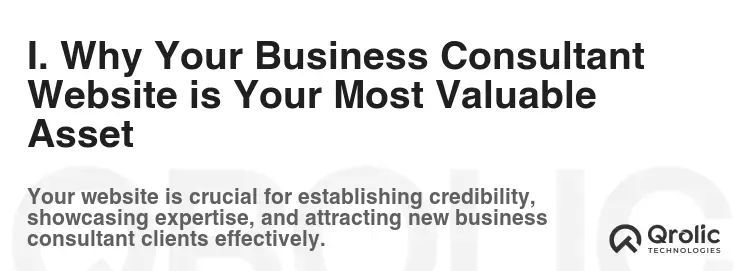
Let’s face it: in today’s world, your website isn’t just an online brochure. It’s your digital storefront, your 24/7 salesperson, and often, the first impression you make on potential clients. For business consultants, a professional, engaging, and informative website is absolutely crucial. Why?
A. Establishing Authority and Trust: The Foundation of Consulting
Clients hire consultants for their expertise. Your website is the perfect platform to showcase that expertise. It’s where you demonstrate your knowledge, share your insights, and build trust with potential clients. A well-designed website exudes professionalism and credibility, immediately positioning you as a reliable authority in your field.
B. Generating Leads and Converting Prospects: Turning Clicks into Clients
Your website should be a lead generation machine. Strategic calls to action, compelling content, and easy navigation guide visitors through the sales funnel, converting them from curious browsers to qualified leads. Think of it as your always-on marketing team, working tirelessly to attract and convert prospects.
C. Showcasing Your Expertise and Services: Letting Your Work Speak for Itself
No more endless elevator pitches! Your website allows you to clearly and concisely outline your services, target industries, and the specific problems you solve. Case studies, testimonials, and portfolio pieces let your past successes speak for themselves, building confidence in your abilities.
D. Expanding Your Reach and Visibility: Reaching Clients You Never Knew Existed
A properly optimized website acts as a magnet for search engines, attracting potential clients who are actively seeking business consulting services. By implementing SEO best practices, you can significantly increase your online visibility and reach a wider audience than traditional marketing methods allow. Think global, act local.
E. Streamlining Communication and Building Relationships: Fostering Long-Term Partnerships
Your website can streamline communication with potential and existing clients. Contact forms, FAQs, and appointment scheduling tools make it easy for people to connect with you. Blog posts and newsletters keep them informed and engaged, fostering long-term relationships and loyalty.
II. Planning Your Business Consultant Website: Laying the Groundwork for Success
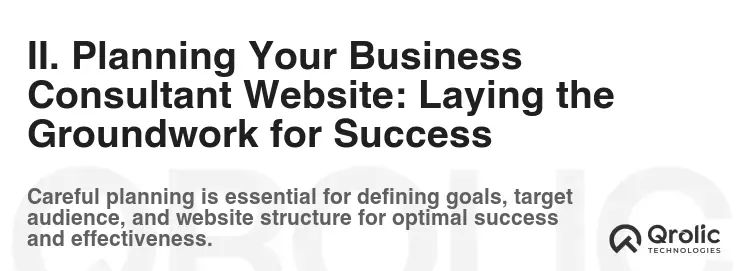
Before diving into the technical aspects, careful planning is essential. This is where you define your target audience, clarify your brand message, and map out the overall structure of your website. This step sets the stage for a website that’s not just visually appealing, but also strategically effective.
A. Defining Your Target Audience: Who Are You Trying to Reach?
Understanding your ideal client is paramount. What industries do they operate in? What challenges do they face? What are their pain points? The more you know about your target audience, the better you can tailor your website’s content and design to resonate with them.
- Niche Specialization: Are you specializing in marketing consulting for tech startups, financial consulting for small businesses, or operations consulting for manufacturing companies?
- Demographics and Psychographics: Consider factors like company size, revenue, location, and the decision-makers within those organizations.
- Pain Points and Goals: What are the specific challenges your target audience faces, and what are their ultimate goals?
B. Defining Your Brand Identity: Creating a Unique and Memorable Image
Your brand identity is more than just a logo; it’s the essence of your business. It encompasses your values, your mission, and the overall experience you deliver to your clients. Your website should consistently reflect your brand identity, creating a cohesive and memorable experience for visitors.
- Mission Statement: Clearly articulate your purpose and the value you provide to your clients.
- Values: What principles guide your work? (e.g., integrity, innovation, collaboration)
- Visual Branding: Choose a color palette, typography, and imagery that reflect your brand’s personality and appeal to your target audience.
C. Choosing a Domain Name and Hosting Provider: Establishing Your Online Presence
Your domain name is your website’s address, and your hosting provider is where your website lives. Choose a domain name that’s memorable, easy to spell, and relevant to your business. Select a hosting provider that offers reliable performance, security, and scalability.
- Domain Name Selection: Opt for a “.com” domain if possible. Keep it short, brandable, and avoid hyphens if possible.
- Hosting Options: Consider shared hosting, VPS hosting, or dedicated hosting, depending on your website’s traffic and resource requirements. Look for providers with good uptime guarantees and responsive customer support.
- SSL Certificate: Ensure your hosting provider offers SSL certificates to secure your website and build trust with visitors (indicated by the “https” in your website address).
D. Mapping Out Your Website Structure: Creating a User-Friendly Experience
A well-structured website is easy to navigate and provides a clear path for visitors to find the information they need. Plan out the key pages of your website and how they will be interconnected.
- Essential Pages:
- Homepage: Your website’s front door, providing a clear overview of your services and value proposition.
- About Us: Tell your story, showcase your team, and build credibility.
- Services: Detail the specific consulting services you offer, highlighting the benefits for your clients.
- Case Studies: Showcase successful projects and demonstrate your expertise.
- Testimonials: Feature positive feedback from satisfied clients to build trust.
- Blog: Share your insights, thought leadership, and industry expertise.
- Contact Us: Provide a clear and easy way for visitors to get in touch.
E. Keyword Research: Identifying the Terms Your Clients Are Searching For (Consulting Design)
Understanding the keywords your target audience uses when searching for business consultants is crucial for SEO. Conduct thorough keyword research to identify the terms you should be targeting in your website’s content. This includes long-tail keywords, question-based keywords, and location-based keywords (e.g., “business consultant in [city]”). Tools like Google Keyword Planner, Ahrefs, and SEMrush can be invaluable for this process. Consider keywords related to “consulting design,” as clients seeking website design for their consulting business might be looking for a specific type of service. (consulting design)
III. Choosing the Right Platform: Building Your Website on a Solid Foundation

Several platforms can be used to build a business consultant website. Each platform has its own strengths and weaknesses, so it’s important to choose the one that best fits your needs and technical skills.
A. WordPress: The Power and Flexibility of Open Source
WordPress is the most popular content management system (CMS) in the world, powering a significant percentage of all websites. Its open-source nature provides unparalleled flexibility and customization options.
- Pros:
- Highly Customizable: Thousands of themes and plugins allow you to create a unique and feature-rich website.
- SEO-Friendly: WordPress is inherently SEO-friendly, and there are many plugins available to further optimize your site.
- Large Community: A vast community of developers and users provides ample support and resources.
- Content Management: Easy-to-use content management features make it simple to create and update your website’s content.
- Cons:
- Requires Technical Skills: While WordPress is relatively user-friendly, some technical skills are required for customization and maintenance.
- Security Risks: Due to its popularity, WordPress is a frequent target for hackers. Security measures are essential.
- Plugin Conflicts: Installing too many plugins can sometimes lead to conflicts and performance issues.
B. Squarespace: The All-in-One Simplicity
Squarespace is a website builder that offers an all-in-one solution, including hosting, design templates, and content management tools.
- Pros:
- User-Friendly: Squarespace is known for its intuitive interface and ease of use, making it a good option for beginners.
- Beautiful Templates: Squarespace offers a wide range of professionally designed templates.
- All-in-One Solution: Hosting, security, and updates are all handled by Squarespace.
- Cons:
- Limited Customization: Squarespace offers less customization than WordPress.
- Higher Cost: Squarespace plans can be more expensive than WordPress hosting.
- Less SEO Control: While Squarespace is SEO-friendly, it offers less control over SEO settings than WordPress.
C. Wix: The Drag-and-Drop Ease
Wix is another popular website builder that offers a drag-and-drop interface, making it easy to create a website without coding.
- Pros:
- Easy to Use: The drag-and-drop interface makes it simple to create a website visually.
- Wide Range of Templates: Wix offers a large selection of templates for various industries.
- App Market: The Wix App Market provides access to a variety of add-ons and integrations.
- Cons:
- Limited Customization: Similar to Squarespace, Wix offers less customization than WordPress.
- SEO Limitations: Wix has historically had SEO limitations, although these have improved in recent years.
- Ads on Free Plans: Free Wix plans include Wix branding and ads.
D. Considerations for Choosing the Right Platform: Balancing Simplicity and Control
The best platform for your business consultant website depends on your specific needs and technical skills.
- Technical Skills: If you’re comfortable with coding and website management, WordPress offers the most flexibility. If you prefer a simpler, more user-friendly solution, Squarespace or Wix might be a better fit.
- Budget: Consider the cost of hosting, themes, and plugins when choosing a platform. WordPress is often the most cost-effective option in the long run.
- SEO Needs: If SEO is a top priority, WordPress offers the most control and flexibility. However, Squarespace and Wix can also be optimized for search engines.
- Scalability: Consider how your website will scale as your business grows. WordPress offers the most scalability and flexibility for future growth. (business consultant website)
IV. Designing Your Website: Creating a Visually Appealing and Engaging Experience
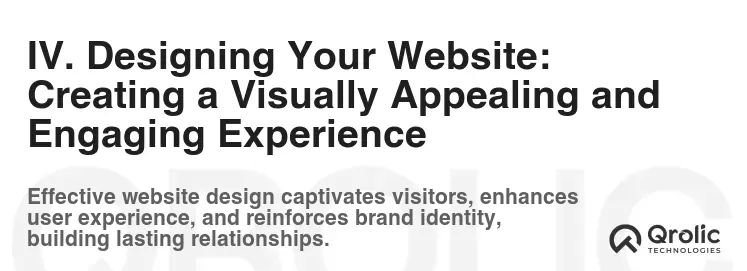
Your website’s design is crucial for attracting and retaining visitors. A visually appealing and engaging design will make a positive first impression and encourage visitors to explore your website further.
A. Choosing a Theme or Template: Starting with a Solid Foundation
Whether you’re using WordPress, Squarespace, or Wix, choosing the right theme or template is essential. Look for a design that is clean, professional, and relevant to your industry.
- Professionalism: Choose a theme or template that exudes professionalism and credibility.
- Clean Design: Avoid cluttered designs with too many elements. Opt for a clean and minimalist aesthetic.
- Mobile Responsiveness: Ensure your chosen theme or template is mobile-responsive, meaning it adapts to different screen sizes.
- Customization Options: Choose a theme or template that offers sufficient customization options to match your brand identity.
B. Optimizing for Mobile: Catering to On-the-Go Users
Mobile devices account for a significant portion of website traffic. It’s essential to ensure your website is optimized for mobile devices, providing a seamless experience for users on smartphones and tablets.
- Responsive Design: Use a responsive design framework that automatically adapts to different screen sizes.
- Mobile-Friendly Navigation: Ensure your website’s navigation is easy to use on mobile devices.
- Fast Loading Times: Optimize images and other elements to ensure your website loads quickly on mobile devices.
- Touch-Friendly Design: Design your website with touch interactions in mind.
C. Using High-Quality Images and Videos: Enhancing Visual Appeal
High-quality images and videos can significantly enhance your website’s visual appeal and engagement. Use professional-quality images and videos that are relevant to your business and target audience.
- Professional Photography: Invest in professional photography to showcase your team, your office, and your work.
- Stock Photos: Use high-quality stock photos from reputable sources like Unsplash, Pexels, and Shutterstock.
- Video Marketing: Incorporate video into your website to explain your services, share testimonials, or provide valuable content.
- Image Optimization: Optimize images for web use to reduce file size and improve loading times.
D. Implementing a Clear and Intuitive Navigation: Guiding Users Through Your Website
Clear and intuitive navigation is essential for guiding visitors through your website and helping them find the information they need.
- Simple Menu Structure: Use a simple and logical menu structure that is easy to understand.
- Clear Labels: Use clear and concise labels for your menu items.
- Search Function: Provide a search function to allow visitors to quickly find specific information.
- Breadcrumbs: Use breadcrumbs to show visitors their current location on your website.
E. Color Palette and Typography: Creating a Consistent Brand Experience
Your website’s color palette and typography should be consistent with your brand identity and create a visually appealing experience for visitors.
- Brand Colors: Use your brand colors to create a cohesive look and feel.
- Legible Typography: Choose fonts that are easy to read and visually appealing.
- Font Hierarchy: Use different font sizes and styles to create a clear visual hierarchy.
- Color Contrast: Ensure sufficient color contrast between text and background for readability.
V. Creating Compelling Content: Showcasing Your Expertise and Value
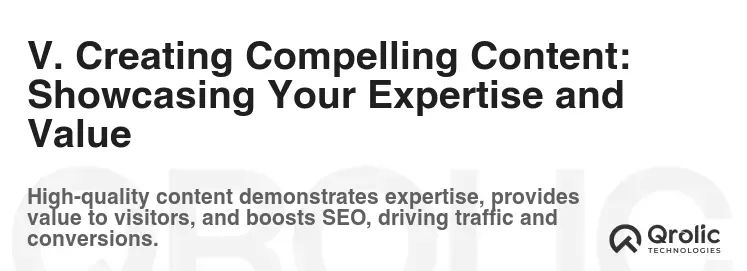
Your website’s content is what will ultimately attract and convert visitors. Create compelling content that showcases your expertise, provides value to your target audience, and encourages them to take action.
A. Writing Engaging Homepage Copy: Capturing Attention Immediately
Your homepage is your website’s front door, so it’s essential to make a strong first impression. Your homepage copy should clearly communicate your value proposition and capture the attention of visitors immediately.
- Headline: Use a compelling headline that clearly states the benefit of working with you.
- Value Proposition: Clearly articulate your value proposition and what makes you unique.
- Call to Action: Include a clear call to action that encourages visitors to take the next step.
- Visual Appeal: Use high-quality images and videos to enhance the visual appeal of your homepage.
B. Crafting Informative Service Pages: Detailing Your Offerings
Your service pages should provide detailed information about the specific consulting services you offer. Highlight the benefits of your services and explain how you can help your clients achieve their goals.
- Clear Descriptions: Provide clear and concise descriptions of your services.
- Benefits-Oriented Language: Focus on the benefits of your services rather than just the features.
- Targeted Keywords: Use targeted keywords to improve your service pages’ search engine rankings.
- Case Studies: Include case studies to showcase successful projects and demonstrate your expertise.
C. Developing Compelling Case Studies: Showcasing Your Successes
Case studies are a powerful way to demonstrate your expertise and build trust with potential clients. Showcase successful projects and highlight the results you achieved for your clients.
- Problem: Clearly state the problem that your client was facing.
- Solution: Describe the solution you implemented to address the problem.
- Results: Quantify the results you achieved for your client.
- Client Testimonial: Include a quote from your client praising your work.
D. Gathering and Displaying Testimonials: Building Trust and Credibility
Testimonials are a valuable form of social proof that can significantly increase your website’s credibility. Gather testimonials from satisfied clients and prominently display them on your website.
- Authenticity: Ensure that your testimonials are authentic and genuine.
- Specificity: Encourage clients to provide specific details about their experience working with you.
- Variety: Include a variety of testimonials from different clients and industries.
- Visual Appeal: Use photos or videos to make your testimonials more engaging.
E. Creating a Blog: Sharing Your Expertise and Providing Value
A blog is a great way to share your expertise, provide value to your target audience, and improve your website’s search engine rankings.
- Relevant Topics: Choose topics that are relevant to your target audience and your consulting services.
- High-Quality Content: Create high-quality, informative, and engaging content.
- Consistent Posting Schedule: Maintain a consistent posting schedule to keep your audience engaged.
- SEO Optimization: Optimize your blog posts for search engines using relevant keywords.
F. Optimizing Content for SEO: Attracting Organic Traffic
Optimizing your website’s content for search engines is essential for attracting organic traffic and reaching a wider audience.
- Keyword Research: Conduct thorough keyword research to identify the terms your target audience is searching for.
- On-Page Optimization: Optimize your website’s title tags, meta descriptions, and header tags with relevant keywords.
- Content Optimization: Incorporate relevant keywords into your website’s content naturally.
- Link Building: Build high-quality backlinks from reputable websites to improve your website’s authority.
VI. Implementing Essential Features: Enhancing Functionality and User Experience
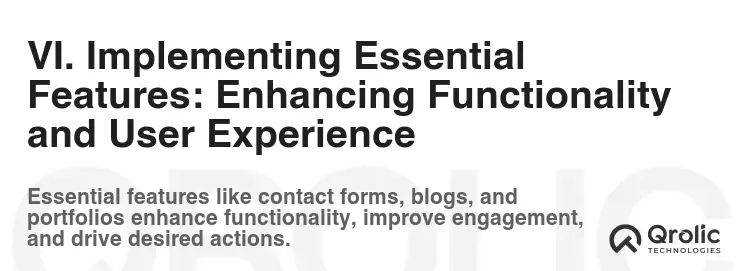
Beyond the core design and content, certain features are crucial for enhancing your website’s functionality and user experience. These features streamline communication, simplify processes, and ultimately contribute to a more effective website.
A. Contact Forms: Making it Easy to Connect
A well-designed contact form makes it easy for potential clients to reach out to you with inquiries or requests for proposals.
- Essential Fields: Include essential fields such as name, email address, and message.
- Clear Call to Action: Use a clear call to action, such as “Submit” or “Send Message.”
- Spam Protection: Implement spam protection to prevent unwanted submissions.
- Thank You Message: Display a thank you message after the form has been submitted.
B. Appointment Scheduling Tools: Streamlining the Booking Process
Appointment scheduling tools allow potential clients to easily schedule consultations or meetings with you directly through your website.
- Integration with Calendar: Choose a tool that integrates with your existing calendar system.
- Customizable Availability: Set your availability and block out times when you’re unavailable.
- Automated Reminders: Send automated reminders to clients to reduce no-shows.
- Payment Processing: Consider a tool that allows you to collect payments for consultations.
C. Live Chat: Providing Real-Time Support
Live chat provides real-time support to website visitors, allowing you to answer their questions and address their concerns immediately.
- 24/7 Availability: Consider offering 24/7 live chat support to cater to visitors in different time zones.
- Proactive Chat: Initiate chats with visitors who are browsing specific pages or spending a long time on your website.
- Chatbots: Use chatbots to answer common questions and handle basic inquiries.
- Integration with CRM: Integrate your live chat tool with your CRM to track customer interactions.
D. Email Marketing Integration: Building Your Mailing List
Email marketing is a powerful way to stay in touch with potential clients, share valuable content, and promote your services.
- Sign-Up Forms: Include email sign-up forms on your website to capture leads.
- Incentives: Offer incentives, such as free ebooks or webinars, to encourage visitors to sign up for your email list.
- Segmentation: Segment your email list based on interests and demographics to send targeted messages.
- Automation: Use email automation to send welcome emails, nurture leads, and promote your services.
E. Social Media Integration: Expanding Your Reach and Engagement
Integrating your website with your social media profiles allows you to expand your reach, increase engagement, and drive traffic to your website.
- Social Sharing Buttons: Include social sharing buttons on your blog posts and service pages to make it easy for visitors to share your content.
- Social Media Feeds: Display your social media feeds on your website to showcase your latest updates.
- Social Login: Allow visitors to log in to your website using their social media accounts.
- Social Advertising: Use social media advertising to promote your website and reach a wider audience.
VII. Testing and Launching Your Website: Ensuring a Smooth and Successful Debut

Before launching your website, it’s essential to thoroughly test it to ensure that everything is working properly and that the user experience is seamless.
A. Cross-Browser Compatibility Testing: Ensuring Consistent Performance
Test your website on different web browsers, such as Chrome, Firefox, Safari, and Edge, to ensure that it displays correctly and functions properly on all browsers.
B. Mobile Responsiveness Testing: Verifying Mobile-Friendliness
Test your website on different mobile devices, such as smartphones and tablets, to ensure that it is mobile-responsive and provides a seamless user experience on all devices.
C. Functionality Testing: Ensuring All Features Work as Expected
Test all of your website’s features, such as contact forms, appointment scheduling tools, and live chat, to ensure that they are working properly and that data is being captured and processed correctly.
D. Content Review: Proofreading and Accuracy
Review all of your website’s content to ensure that it is free of errors, accurate, and consistent with your brand messaging.
E. Speed Optimization: Ensuring Fast Loading Times
Optimize your website’s speed to ensure that it loads quickly, providing a positive user experience and improving your search engine rankings.
F. Security Audit: Protecting Your Website and Data
Conduct a security audit to identify and address any potential security vulnerabilities on your website.
G. Launching Your Website: Making it Live to the World
Once you’ve thoroughly tested your website, you’re ready to launch it to the world.
- DNS Propagation: Allow time for your DNS records to propagate, which can take up to 48 hours.
- Submit to Search Engines: Submit your website to search engines, such as Google and Bing, to ensure that it is indexed and ranked in search results.
- Monitor Performance: Monitor your website’s performance using tools like Google Analytics to track traffic, engagement, and conversions.
VIII. Promoting Your Website: Driving Traffic and Generating Leads
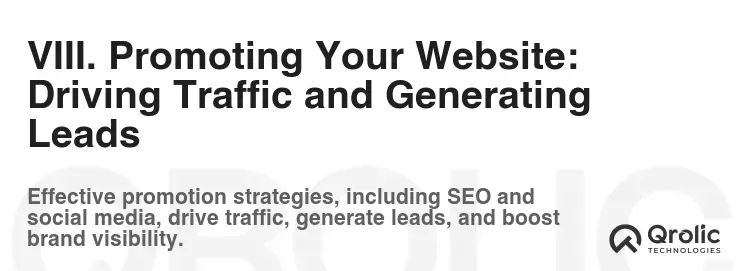
Launching your website is just the first step. You need to actively promote it to drive traffic and generate leads.
A. Search Engine Optimization (SEO): Attracting Organic Traffic
Continue to optimize your website for search engines to attract organic traffic.
- Keyword Research: Regularly conduct keyword research to identify new opportunities.
- On-Page Optimization: Continuously optimize your website’s title tags, meta descriptions, and header tags.
- Content Marketing: Create high-quality, informative, and engaging content that attracts and engages your target audience.
- Link Building: Build high-quality backlinks from reputable websites.
B. Social Media Marketing: Engaging Your Audience and Driving Traffic
Use social media marketing to engage your audience, build your brand, and drive traffic to your website.
- Consistent Posting: Maintain a consistent posting schedule to keep your audience engaged.
- Engaging Content: Share engaging content that is relevant to your target audience.
- Social Media Advertising: Use social media advertising to reach a wider audience.
C. Email Marketing: Nurturing Leads and Driving Conversions
Continue to use email marketing to nurture leads, build relationships, and drive conversions.
- Segmentation: Segment your email list based on interests and demographics.
- Personalized Messages: Send personalized messages that are tailored to your subscribers’ needs.
- Promotional Offers: Offer exclusive discounts and promotions to your email subscribers.
D. Paid Advertising: Reaching a Targeted Audience
Use paid advertising platforms, such as Google Ads and social media advertising, to reach a targeted audience and drive traffic to your website.
- Keyword Targeting: Target relevant keywords with your Google Ads campaigns.
- Audience Targeting: Target specific demographics and interests with your social media advertising campaigns.
- A/B Testing: Test different ad copy and creative to optimize your campaigns.
E. Content Marketing: Providing Value and Attracting Leads
Create valuable and informative content that attracts and engages your target audience.
- Blog Posts: Write informative and engaging blog posts that address your target audience’s pain points.
- Ebooks and Whitepapers: Create ebooks and whitepapers that provide in-depth information on specific topics.
- Webinars: Host webinars that educate your audience and showcase your expertise.
- Infographics: Create visually appealing infographics that present complex information in an easy-to-understand format.
IX. Qrolic Technologies: Your Partner in Building a Powerful Online Presence

At Qrolic Technologies (https://qrolic.com/), we understand the unique challenges that business consultants face in building a strong online presence. We offer a comprehensive range of services to help you create a website that not only looks great but also drives results.
A. Custom Website Design and Development: Tailored to Your Specific Needs
We specialize in custom website design and development, creating websites that are tailored to your specific needs and brand identity. Our team of experienced designers and developers will work closely with you to create a website that reflects your expertise, showcases your services, and attracts your ideal clients. Whether it’s WordPress or a custom solution, we make sure it aligns with your goals.
B. SEO Optimization: Ranking Higher in Search Results
Our SEO experts will optimize your website to rank higher in search results, driving more organic traffic and generating more leads. We’ll conduct thorough keyword research, optimize your website’s content, and build high-quality backlinks to improve your website’s authority.
C. Content Creation: Engaging Your Audience and Showcasing Your Expertise
Our team of skilled writers can create compelling content that engages your audience, showcases your expertise, and drives conversions. We’ll write blog posts, case studies, testimonials, and other types of content that resonate with your target audience and help you establish yourself as a thought leader in your industry. We can also support Consulting design efforts.
D. Digital Marketing: Driving Traffic and Generating Leads
We offer a full suite of digital marketing services, including social media marketing, email marketing, and paid advertising, to help you drive traffic to your website and generate leads. We’ll work with you to develop a comprehensive digital marketing strategy that aligns with your business goals and budget.
E. Website Maintenance and Support: Ensuring Your Website Stays Up-to-Date and Secure
We provide ongoing website maintenance and support to ensure that your website stays up-to-date, secure, and functioning properly. We’ll handle all of the technical aspects of website management, so you can focus on running your business.
With Qrolic Technologies, you can rest assured that your website is in good hands. We’re committed to helping you build a powerful online presence that attracts clients, generates leads, and drives business growth. Visit our website at https://qrolic.com/ to learn more about our services and how we can help you achieve your online goals.
X. Maintaining and Updating Your Website: Ensuring Long-Term Success

Creating a successful business consultant website is an ongoing process. It’s essential to regularly maintain and update your website to ensure that it remains relevant, engaging, and effective.
A. Regularly Updating Content: Keeping Your Website Fresh and Relevant
Regularly update your website’s content to keep it fresh, relevant, and engaging.
- New Blog Posts: Publish new blog posts regularly to share your insights and expertise.
- Updated Case Studies: Add new case studies to showcase your recent successes.
- Fresh Testimonials: Gather and display fresh testimonials from satisfied clients.
- Updated Service Pages: Review and update your service pages to reflect any changes in your offerings.
B. Monitoring Website Performance: Tracking Key Metrics
Monitor your website’s performance using tools like Google Analytics to track key metrics, such as traffic, engagement, and conversions.
- Traffic Sources: Identify your website’s top traffic sources to understand where your visitors are coming from.
- Bounce Rate: Monitor your website’s bounce rate to identify pages that need improvement.
- Conversion Rate: Track your website’s conversion rate to measure the effectiveness of your marketing efforts.
- Keyword Rankings: Monitor your website’s keyword rankings to track your progress in search engine optimization.
C. Security Updates: Protecting Your Website from Threats
Regularly update your website’s security software to protect it from threats.
- WordPress Updates: Install the latest WordPress updates to patch security vulnerabilities.
- Plugin Updates: Update your plugins to the latest versions to fix security bugs.
- Security Scans: Run regular security scans to identify and address any potential security vulnerabilities.
- Strong Passwords: Use strong passwords for your website’s administrator accounts.
D. Plugin Updates: Ensuring Compatibility and Functionality
Regularly update your website’s plugins to ensure that they are compatible with the latest version of WordPress and that they are functioning properly.
E. Theme Updates: Maintaining a Modern and Functional Design
Update your website’s theme to maintain a modern and functional design and to take advantage of new features and improvements.
By following these steps, you can create a business consultant website that effectively showcases your expertise, attracts clients, generates leads, and drives business growth. Remember to be patient, persistent, and adaptable, and always strive to provide value to your target audience. Your website is your most valuable asset, so invest in it wisely and nurture it over time.






